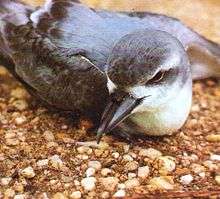Salvin's prion
| Salvin's prion | |
|---|---|
 | |
| Scientific classification | |
| Kingdom: | Animalia |
| Phylum: | Chordata |
| Class: | Aves |
| Order: | Procellariiformes |
| Family: | Procellariidae |
| Genus: | Pachyptila |
| Species: | P. salvini |
| Binomial name | |
| Pachyptila salvini (Mathews, 1912) | |
| Subspecies | |
|
P. salvini salvini (Mathews, 1912) P. salvini macgillivrayi | |
Salvin's prion, Pachyptila salvini, also known as medium-billed prion, is a species of seabird in the petrel family Procellariidae.
Taxonomy
Salvin's prion is a member of the Pachyptila genus, and along with the blue petrel, they make up the prions. They in turn are members of the Procellariidae family, and the Procellariiformes order. The prions are small and typically eat just zooplankton;[2] however as a member of the Procellariiformes, they share certain identifying features. First, they have nasal passages that attach to the upper bill called naricorns. Although the nostrils on the prion are on top of the upper bill. The bills of Procellariiformes are also unique in that they are split into between 7 and 9 horny plates. They produce a stomach oil made up of wax esters and triglycerides that is stored in the proventriculus. This is used against predators as well as an energy rich food source for chicks and for the adults during their long flights.[3] Finally, they also have a salt gland that is situated above the nasal passage and helps desalinate their bodies, due to the high amount of ocean water that they imbibe. It excretes a high saline solution from their nose.[4]
Subspecies
Salvin's prion has two subspecies:
- Pachyptila salvini salvini, the nominate subspecies, breeds on Prince Edward Island and the Crozet Islands[5]
- Pachyptila salvini macgillivray breeds on St. Paul Island and Amsterdam Island[5]
Etymology
The name Pachyptila comes from the Greek words pakhus and ptilon. Pakhus means "thick" or "stout" and ptilon means "a feather". Also from the Greek language, prion comes from the word priōn meaning "a saw", which is in reference to its serrated edges of its bill.[6] The species is named for the British ornithologist Osbert Salvin.
Description
Salvin's prion is a small 29 cm (11 in) petrel with grey and white plumage, and a blue bill.[7] Like the broad-billed prion it has lamellae in its bill in order to filter seawater for food.
Behaviour
Breeding

This small prion breeds colonially on a number of subantarctic islands in the southern Indian Ocean. The colonies of medium-billed prions are attended nocturnally in order to avoid predation by skuas. The nests are concealed in burrows usually dug into soil. Nests are attended regularly for several months prior to breeding. A single egg is laid in November or early December, which is incubated for around 50 days. Both parents share the incubation duties and feed the chick once it is hatched. The chicks fledge around 60 days after hatching.
Feeding
The main components of its diet are amphipods and krill, although it will also take fish and squid. In addition to filter feeding, food is obtained by seizing and hydroplaning.[2]
Range and habitat
Salvin's prion breeds principally on Île aux Cochons in the Crozet Islands, where four million pairs are thought to breed. Other breeding colonies include Prince Edward Island, St Paul Island and Amsterdam Island. At sea they range from South Africa eastwards to New Zealand.[5]
Conservation
Salvin's prion is not considered threatened. Although numbers have declined on some islands where rats and feral cats have been introduced, the world population is estimated at around 12 million birds. Consequently, they are given a classification of Least Concern.[1][8]
Footnotes
- 1 2 BirdLife International (2012). "Pachyptila salvini". IUCN Red List of Threatened Species. Version 2013.2. International Union for Conservation of Nature. Retrieved 26 November 2013.
- 1 2 Maynard, B. J. (2003)
- ↑ Double, M. C. (2003)
- ↑ Ehrlich, Paul R. (1988)
- 1 2 3 Clements, James (2007)
- ↑ Gotch, A. T. (1995)
- ↑ ZipCode Zoo (19 Jun 2009)
- ↑ BirdLife International (2009)
References
- BirdLife International (2009). "Medium-billed Prion - BirdLife Species Factsheet". Data Zone. Retrieved 17 Jul 2009.
- Brooke, M. (2004). "Procellariidae". Albatrosses And Petrels Across The World. Oxford, UK: Oxford University Press. ISBN 0-19-850125-0.
- Clements, James (2007). The Clements Checklist of the Birds of the World (6th ed.). Ithaca, NY: Cornell University Press. ISBN 978-0-8014-4501-9.
- Double, M. C. (2003). "Procellariiformes (Tubenosed Seabirds)". In Hutchins, Michael; Jackson, Jerome A.; Bock, Walter J.; Olendorf, Donna. Grzimek's Animal Life Encyclopedia. 8 Birds I Tinamous and Ratites to Hoatzins. Joseph E. Trumpey, Chief Scientific Illustrator (2nd ed.). Farmington Hills, MI: Gale Group. pp. 107–111. ISBN 0-7876-5784-0.
- Ehrlich, Paul R.; Dobkin, David, S.; Wheye, Darryl (1988). The Birders Handbook (First ed.). New York, NY: Simon & Schuster. pp. 29–31. ISBN 0-671-65989-8.
- Gotch, A. F. (1995) [1979]. "Albatrosses, Fulmars, Shearwaters, and Petrels". Latin Names Explained A Guide to the Scientific Classifications of Reptiles, Birds & Mammals. New York, NY: Facts on File. p. 192. ISBN 0-8160-3377-3.
- Maynard, B. J. (2003). "Shearwaters, petrels, and fulmars (Procellariidae)". In Hutchins, Michael; Jackson, Jerome A.; Bock, Walter J.; Olendorf, Donna. Grzimek's Animal Life Encyclopedia. 8 Birds I Tinamous and Ratites to Hoatzins. Joseph E. Trumpey, Chief Scientific Illustrator (2nd ed.). Farmington Hills, MI: Gale Group. pp. 123–133. ISBN 0-7876-5784-0.
- ZipCode Zoo (19 Jun 2009). "Pachyptila salvini (Medium-Billed Prion)". BayScience Foundation. Retrieved 26 Jul 2009.
